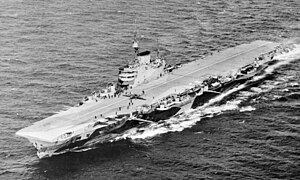HMS Indefatigable (R10)
This article's lead section may be too short to adequately summarize the key points. (September 2009) |

| |
| History | |
|---|---|
| Builder | John Brown |
| Laid down | 3 November 1939 |
| Launched | 8 December 1942 |
| Commissioned | 3 May 1944 |
| Decommissioned | December 1946 |
| Commissioned | 1950 |
| Decommissioned | September 1954 |
| Fate | Scrapped in November 1956 |
| General characteristics | |
| Class and type | Implacable class aircraft carrier |
| Displacement | list error: <br /> list (help) 23,825 tons standard 32,624 tons full load |
| Length | 766.5 ft (233.6 m) |
| Beam | 95.75 ft (29.18 m) |
| Draught | 29 ft (8.8 m) |
| Propulsion | Steam Turbines (8 Admiralty 3-drum boilers, 4 shafts, Parsons geared turbines), 148,000 shp. |
| Speed | 32 knots (59 km/h) |
| Range | 11,000 nautical miles (20,000 km) at 14 knots (26 km/h) |
| Complement | 1,400 (including air group) |
| Armament | list error: <br /> list (help) 8 × twin QF 4.5 inch naval guns 42 × QF 2 pounder naval guns 40 × Oerlikon 20 mm guns |
| Aircraft carried | 73 in 1944 with a permanent deck park. |
HMS Indefatigable (R10) was an Implacable-class aircraft carrier of the British Royal Navy.
History
Built at the famous John Brown Yard on the Clyde, at Clydebank, Scotland, Indefatigable was laid down on 3 November 1939 and launched on 8 December 1942. She commissioned into the Royal Navy on 3 May 1944, joining the Home Fleet. The ship's first commander was Captain Q. D. Graham.
The first mission (rather in the form of a 'working-up' exercise) was a set of raids on the German battleship Tirpitz in the fjords of Norway. It was not a spectacular success with all sorts of equipment problems showing up.
After dockyard work on the problems the ship sailed on 19 November 1944 for the Far East to join the British Pacific Fleet as flagship of Rear-Admiral Philip Vian (former captain of Cossack) who commanded the carrier group of the BPF. He transferred his flag to Indomitable on arrival at Colombo on 10 December 1944.
On 1 April 1945, while operating in support of the Okinawa operation, the ship was hit at the base of the superstructure by a kamikaze suicide bomber. Fourteen men were killed. Thanks to her armoured deck however, Indefatigable was able to operate aircraft again after just five hours.
Indefatigable was present at the formal surrender of the Japanese on 2 September in Tokyo Bay. She later helped to repatriate Allied POWs held in Japan and was used as a spotting ship for later US nuclear tests in the Pacific ocean.
She decommissioned after the war but recommissioned in 1950 as a training ship. After being decommissioned for the last time, Indefatigable was scrapped in 1956.
Squadrons carried
The ship's squadrons operated a number of aircraft types including the Supermarine Seafire, TBF Avenger and Fairey Firefly. In November 1944 Indefatigable carried 73 aircraft: 40 Seafires, 21 Avengers and 12 Fireflies.
See also
![]() Media related to HMS Indefatigable (R10) at Wikimedia Commons
Media related to HMS Indefatigable (R10) at Wikimedia Commons
References
This article includes a list of references, related reading, or external links, but its sources remain unclear because it lacks inline citations. (May 2008) |
Notes
Bibliography
- Ireland, Bernard. The Illustrated Guide to Aircraft Carriers of the World. Hermes House, London, 2005. ISBN 1-84477-747-2
External links
